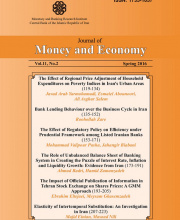
Journal of Money and Economy
Journal of Money and Economy, Vol. 9, No. 2, Spring 2014 (مقاله علمی وزارت علوم)
مقالات
حوزه های تخصصی:
This paper seeks to investigate the determinants of banking network profitability in Iran from 2007 to 2012. The results of our study indicate that both bank-specific factors and macroeconomic factors influence banks’ profitability in Iran. Results confirm that bank profitability is significantly influenced by investment to total assets ratio, non-performing loans to total assets ratio, and time deposit to total assets ratio. Among external factors, it turns out that economic growth rate has a significant positive impact on bank profitability. JEL Classifications: C23, G21, M20
Low Statutory Power of the Central Bank of Islamic Republic of Iran(مقاله علمی وزارت علوم)
حوزه های تخصصی:
Once the responsibilities of central bank increases, developing good governance for achieving its different aims to satisfy the required statutory power becomes more complicated. In the case of the central bank of Islamic republic of Iran - as monetary policymaker and supervisor-this issue is valid as well. Considering the necessity of independency, accountability, and transparency for developing good governance to achieve required statutory power, current laws on the central bank and banking, and the bills on these laws have been evaluated. Since these bills have not been developed based on the importance of the main pillars of central bank governance regarding its core functions and the current laws do not support these pillars as well, we cannot expect that the central bank attains required statutory power. Hence, these bills should be modified to consider these pillars and enhance the level of central bank’s governance and its statutory power. JEL Classification: E52, E58.
The Inflationary Impact of Energy Subsidy Reform in Iran(مقاله علمی وزارت علوم)
حوزه های تخصصی:
Iran has suffered ever-increasing domestic energy consumption, mostly because of its long-standing price control policy. To decelerate this trend, Iran began a reform on its energy subsidy system in December 2010. This paper examines the inflationary impact of the energy subsidy reform on different Iranian non-energy sectors and urban and rural households by making an updated input–output price model and deriving the energy price elasticities (the percentage change in price of non-energy sectors in response to a one percent change in price of energy carriers). The results show that full reform (increasing the domestic energy prices immediately to average regional market prices) would increase consumption prices by 54.1% that impresses the expenditures of urban households more. In addition, the manufacture of non-metallic mineral products, basic metal industries, and transport, storage and communication sectors would experience the largest increase in production prices. Finally, electricity, natural gas and gasoline have the largest impact on production prices. JEL Classification: A11, H70, H71
Oil Price Shocks and Economic Fluctuations in Iran as a Small Open Oil Exporting Economy(مقاله علمی وزارت علوم)
حوزه های تخصصی:
Oil price shocks are the major source of economic instability in oil exporting developing countries, including Iran. In this paper a Multi Sector Dynamic Stochastic General Equilibrium model, with emphasis on optimization of oil sector as a producing sector is designed. Furthermore, an optimizing import sector is introduced into the model by considering the price rigidity in imported goods as a source of inefficiency in a New Keynesian open economy. The impact of oil price shocks on the dynamics of the economic variables is considered during 1988:1-2011:1. For this purpose, the Bayesian approach is used to estimate the model. The impulse response functions show that immediately after an oil price shock, output increases in the oil sector, while in the non-oil sector the result is reverse. Furthermore, GDP, consumption and inflation increase, while the employment and real exchange rate decreases immediately and finally, all the variables converge to their steady state values. JEL Classification: C61, D50, E12, Q43
The Impact of Financial Stress on Iran per Capita GDP over the Period 2000(3)-2011(1)(مقاله علمی وزارت علوم)
حوزه های تخصصی:
Stress in financial markets influences economic agents’ behavior by creating uncertainty and changing the expectations. Critical financial stress can lead to financial crisis. Financial crises are among the events always present in the world economy. Iran is not an exception. This paper aims to study the impact of financial stresses on Iran’s per capita GDP. By using ARDL (Auto Regressive Distributed Lags), the effects of financial stress indices, including foreign currency, stock, and banking markets on Iran’s GDP per capita is estimated. Our findings show that financial stresses in currency market and stock market have positive and negative effects on economic growth respectively. Banking stresses have a positive influence on economic growth. The cumulative impact of financial stresses is positive on Iran’s economy, but is different from the effect of banking stresses with respect to intensity. JEL Classification: E44, G01, O11, O16
Currency Union and Bilateral Trade: Evidence from OIC Countries(مقاله علمی وزارت علوم)
حوزه های تخصصی:
In recent years, there has been an increasing interest in currency unions internationally. The formation of currency union in Organization of Islamic Cooperation (OIC) has drawn much attention of Islamic countries. This paper aims to investigate the effect of currency union formation for trade among 49 Islamic countries over the period 1990-2012 by OCA and Augmented Gravity Model (AGM). The results show that common language, borders, and trade unions had positive and significant effect on trade in OIC countries; and being landlocked and distance between source and host countries had negative and significant effect on bilateral trade. Also, the currency union had positive and significant effects on trade in OIC countries. The evidence thus suggests that regional currency union arrangements stimulate bilateral trade in OIC rigorously. JEL Classification: F47, E49